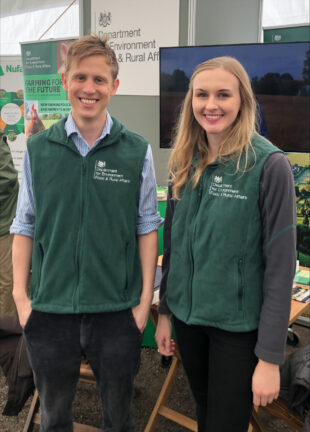https://defrafarming.blog.gov.uk/create-2-year-sown-legume-fallow/
Create 2 year sown legume fallow
Find out how land managers can control black-grass and provide food for pollinators and farmland birds by creating 2 year sown legume fallow.
If you’re completing this action as part of the Sustainable Farming Incentive pilot, how you do it is up to you.
The advice on this page can help you get better environmental and business benefits, but you do not have to follow it to get paid.
About 2 year sown legume fallows
A 2 year legume fallow is sown with a variety of legumes and sometimes grass. It’s used as a break crop to help control problem weeds like black-grass.
Benefits of 2 year legume fallow
By creating a fallow you’ll:
- reduce black-grass populations, meaning you’ll need less herbicide in future crops
- provide food and habitat for pollinators
- help protect neighbouring crops by providing habitat for insects that feed on aphids and other pests
- provide food and shelter for farmland birds and their chicks
- improve soil health
How to sow 2 year legume fallow
Choose your location
Where possible rotate fallows around your farm as part or whole field plots. This will help improve connectivity and allow insects to move around the landscape more easily.
You can put them close to other habitats that provide resources for invertebrates.
To maximise establishment and yield, choose sites that are:
- sunny
- south or south-west facing
- weed-free
Avoid sites that are:
- difficult to access and manage, like remote field corners
- known to have rare arable wildflowers
What to sow
You can sow flower only, or flower and grass mixes.
Use the lower range of the recommended seed rate on light or medium soils. Use the higher end of the rate on heavier soils.
On historic features, do not grow plants whose roots could damage the features. These include deep rooted legumes like lucerne.
Example flower only mix
Sow this seed mix at 15 to 20kg per hectare (kg/ha).
| Flower species | Inclusion rate (%) |
|---|---|
| Alsike clover | 8.00 |
| Bird’s-foot trefoil | 15.00 |
| Black medick | 10.00 |
| Common vetch | 30.00 |
| Lucerne | 10.00 |
| Red clover | 20.00 |
| White clover | 7.00 |
Example grass and flower mix
Sow this seed mix at 20 to 25kg/ha.
| Grass species | Inclusion rate (%) |
|---|---|
| Cock’s-foot | 5.00 |
| Timothy | 20.00 |
| Flower species | Inclusion rate (%) |
|---|---|
| Alsike clover | 6.00 |
| Bird’s-foot trefoil | 11.25 |
| Black medick | 7.50 |
| Common vetch | 22.50 |
| Lucerne | 7.50 |
| Red clover | 15.00 |
| White clover | 5.25 |
You can include grasses at a low rate of 5 to 10kg per ha. This will help to:
- aid seed flow in drills
- provide good ground cover while flower species establish
Avoid vigorous grasses like Italian and perennial ryegrass as they:
- shade out flowers
- produce dense swards that need to be cut more often
- become problem weeds, affecting later crop growth
Ask a seed supplier or agronomist about the most suitable seed mix, especially if you have strongly acidic or alkaline soils. They can advise you on overall sowing rates for the mix you choose.
Create a seedbed
Create a well-consolidated, firm, fine, level and weed-free seedbed before you sow, to improve germination. This is the most effective weed and slug control method.
You can apply a non-selective herbicide more than once to control black-grass.
Avoid:
- ‘fluffy’ overworked seedbeds on lighter soils
- cloddy, uneven seedbeds on heavier soils
You can roll seedbeds before sowing if they are uneven after secondary cultivations.
When to sow
You can establish legume fallows in spring or autumn. It is easier to control grass weeds in spring-sown fallows.
Sow when the weather and soil moisture is best for the crops in the seed mix. In autumn this is usually by mid-September, to make sure you can establish legumes by winter.
Sow spring fallows between March and May.
Sow the seed
Broadcast (scatter) or shallow drill seeds no deeper than 1cm. Small seeds struggle to germinate when sown any deeper.
If your equipment is not suited to sowing low quantities, mix the seed with an inert carrier like barley meal or poultry chick crumb. This helps with seed flow and even distribution.
Mix the seed in the hopper immediately before sowing. This will stop an uneven spread of crops in your fallow.
Roll after sowing. This will:
- keep in moisture
- ensure good seed-to-soil contact
- reduce slug damage
Do not roll waterlogged soils or where there is a risk of ‘capping’ (running rainwater causing the surface to form an impenetrable cap).
How to manage 2 year sown legume fallow
First few months after sowing
Check the plot regularly for:
- successful germination
- any pest damage
If establishment is poor, you might need to re-sow part or all of your plot.
In small areas you can broadcast or shallow drill into the existing plot. You might need to cultivate lightly first to create some bare ground. If your plot has failed on a larger scale, you might need to start again.
If pests like pigeons and mice are taking seeds, try shallow drilling your seed instead of broadcasting. You can also use bird-scaring devices.
First spring and summer after sowing
Cut the legume fallow frequently. This will prevent black-grass from shedding seed.
First cut
Cut around 2 weeks after most of the black-grass has flowered and the seed heads have turned black. For autumn sown fallows this will normally be from late May or early June onwards.
For spring sown fallows, the first cut will normally be from mid-June onwards.
Second cut
Cut around 2 weeks after tillers have completed flowering. For autumn sown fallows this will normally be from late July.
For spring sown fallows this will be 2 to 3 weeks later, around mid-August.
Optional third cut
Black-grass seed can germinate and reach tillering around September. This is often when the sward has been opened up by cutting and hot, dry weather. These seedlings may not have had time to produce seed.
You may need to cut if:
- a strong flush of black-grass seedlings are threatening to shade out flower re-growth
- you need to control other weeds like thistles
To make sure it can grow strongly next spring, aim to leave the sward at least 20cm high over winter.
Second year cut
Cut between March and mid-May to control black-grass. Do not cut again until mid-August.
This will:
- allow plants to flower for as long as possible
- make sure pollen and nectar is available to insects like bees, butterflies, hoverflies and moths
- provide undisturbed nesting opportunities for farmland birds
Remove vegetation
Remove vegetation after all cuts where possible. This will:
- reduce the risk of smothering flower species
- remove nutrients and help stop weeds and grasses from taking over
You can leave small amounts of cuttings if it’s not practical to remove vegetation. Spread these as thinly as possible. A heavy-duty flail will chop up the vegetation and help it rot quicker.
Long-term management
Keep legume fallows for at least 2 years.
Keeping them for a third year can help control severe black-grass problems. Re-establish legume fallows in the same place every 7 to 10 years to secure longer-term control.
To control black-grass, use other measures in intervening cropping years like:
- establishing stale seedbeds before spring cropping
- higher seed rates
- occasional ploughing to bury seeds
Do not plough land at high or very high risk of soil erosion within the arable and horticultural soils standard.
Grazing
You should not graze on the fallow as it can:
- damage flower species and create an open sward with more space for weeds to grow
- stop flowers and grasses from growing quickly enough to shade out weeds like black-grass and thistles
Fertilisers
Do not use nitrogen fertilisers as they will:
- encourage arable weeds like black-grass and cleavers to grow more vigorously
- reduce the ability of legumes to fix nitrogen
Control weeds
Do not apply broad-leaved herbicide once your fallow is established. Most herbicides that are effective on weeds would also kill or damage your flower species.
If you have broad-leaved weeds that are hard to control like common ragwort, docks, nettles or thistles you can:
- apply herbicide by spot spraying or weed wiping
- cut the affected area
- remove them by hand
Control pests
You should only use pesticides as a last resort, where there is a risk of crop failure. This will limit the impact on beneficial insects.
Prevent damage from slugs
In the first few weeks of germination, seedlings can be easily damaged by slugs. Slug populations can build up on heavy soils in particular as a result of:
- sowing brassica crops such as oilseed rape more frequently in the rotation
- using min or no till, resulting in a build-up of trash at or near to the surface that slugs can feed on
- keeping fallows in the same place every year
Only use slug pellets as a last resort to reduce the risk of harm to other wildlife.
If you plan to use slug pellets:
- use test baiting to monitor the slug population
- only consider using pellets if there are 4 or more slugs per trap
- consider ferric phosphate-based pellets which are less toxic to other wildlife
What a successful 2 year sown legume fallow looks like
You’ll see:
- little or no black-grass heading into the second spring or summer after sowing
- significantly less black-grass in following crops
- flowers providing pollen and nectar for insects during the second summer
- a variety of pollinating insects like bumblebees, butterflies, hoverflies, and solitary bees and wasps using your fallow
- farmland birds foraging and sheltering within the fallow


